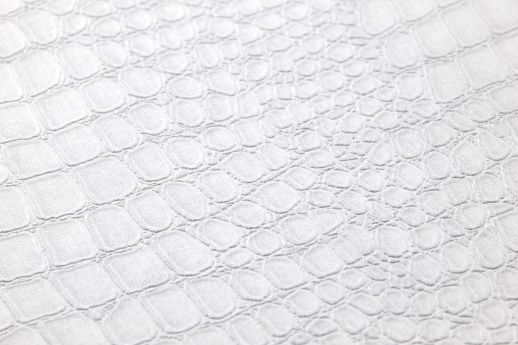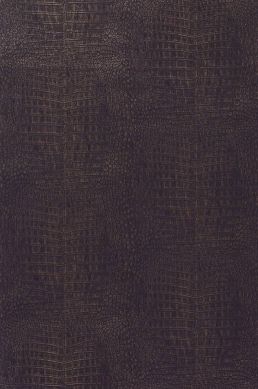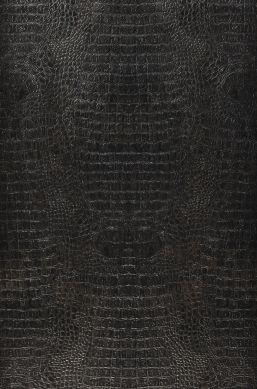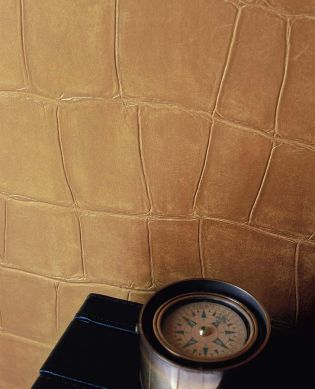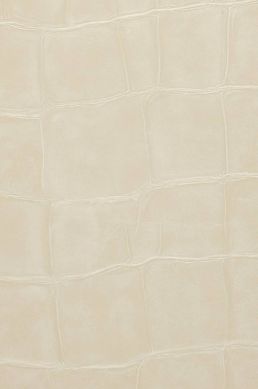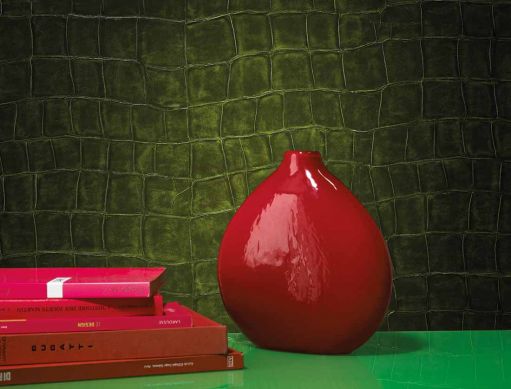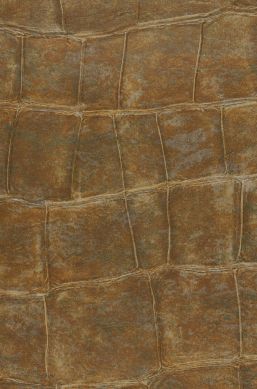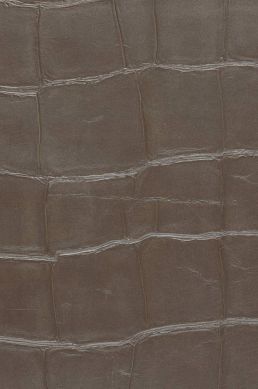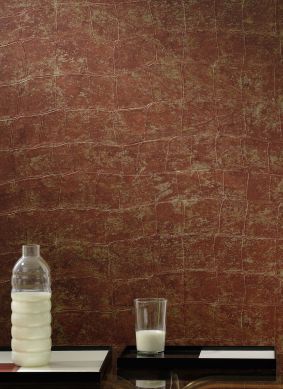Faux Leather Wallpaper
Faux leather wallpaper: The Guide
Leather is natural, sensual and seductive. It is associated with daring cowboys, Italian luxury shoes or Chesterfield furniture. Leather can be soft and supple, rough and antique. Each type of leather has its own special look and feel. Imitation leather wallpapers with vinyl coating can barely be distinguished from real leather. No animal has to be harmed for the positive characteristics of leather (such as warmth, comfort and luxury) to shine.
Table of Contents
- What is faux leather wallpaper made of?
- Which structures and haptic effects are created by embossing?
- What are the basic materials which are reproduced in leather-look wallpaper?
- Which types of processed leather are recreated on wallpaper?
- Which processing methods are used to achieve 3D effects typical for leather?
- What are the most popular colours for leather-look wallpaper?
- Which animal species provide inspiration for faux leather wallpaper?
- Why is imitation leather wallpaper so popular?
- Which rooms are leather-look wallpapers suitable for?
- What are the typical characteristics of imitation leather wallpapers with a vinyl surface?
- Our tips: Interior design & decoration ideas for leather-look wallpapers
What is faux leather wallpaper made of?
Paper or non-woven material is used as the base material for leather-look wallpaper. The surface is coated with vinyl, and the authentic leather patterns are hot-stamped on.
Paper-based or non-woven material as carrier layer
In terms of carrier materials, the main differences are the hanging methods for leather wallpapers. For wallpapers with a carrier layer made of recycled paper, the paste is applied to the back and a specific soaking time is required. If the carrier material is made of non-woven material (mix of cellulose and textile fibres), the paste is applied directly to the wall and soaking times are not necessary.
Vinyl surface coating
The wallpaper surface is coated with polyvinyl chloride (PVC), which makes the front robust, water-resistant and washable. Environment- and health-conscious manufacturers use plasticiser-free polyvinyl chloride and take care to keep overall pollution levels as low as possible.
Hot-stamping the surface
The authentic embossing structures which imitate various real leather types are created with the help of a special hot stamping process on the vinyl surface. These embossing patterns are almost indistinguishable from genuine leather structures. The texture also feels like real leather. It can be velvety soft, rough, cracked or very smooth.
Which structures and haptic effects are created by embossing?
Various structures and tactile textures based on real leather can be embossed on faux leather wallpaper. These include pores, scars, cracks and wrinkles.
Pores
Pores are the main difference in the leather of various animal species; they are determined by the way the hair grows. This can be diagonal or vertical, the pores can be evenly distributed or run parallel to the so-called grain pattern. As a result, the embossing might be like a dot pattern, scale-like or with irregular rhombuses, rectangles and squares.
Scars
The animal species from which the leather originates can be identified by its grain pattern. There is coarse-grained and fine-grained leather, depending on the depth of the scars in the hide. Coarse-grained types include cowhide, elephant leather and crocodile leather. Fine-grained, soft leathers include calfskin and lamb leather.
Cracks
Cracks are the result of dryness, especially in smooth leather. In fashion, cracked leather is used to emphasise the vintage effect. The leather is intended to have an antique look and show differences in colour caused by wear and tear and fading.
Wrinkles
In nature, there are animals with wrinkled skin such as the rhinoceros, the hippopotamus or the elephant. Heavily used leather also tends to have folds and creases. A variety of wrinkle structures can be produced via the embossing process of leather-look wallpaper. This includes imitations of the skin of the animals mentioned above as well as wrinkles, creases or wave-like folds.
What are the basic materials which are reproduced in leather-look wallpaper?
Leather-look wallpapers are based on the two most common leather types: smooth leather and suede. The look and feel can also be reminiscent of soft or robust leather.
Smooth leather
Smooth leather is usually natural, has no scars, is very finely embossed and treated with dyes. It looks cool but also sophisticated and luxurious. Smooth leather imitation wallpapers are very suitable for representative rooms.
Suede
Suede leather (e.g. nubuck) has a roughened, soft and velvety surface. This type of leather has a tactile and warm effect. It is the perfect choice when it comes to creating a cosy and comfortable atmosphere or a sophisticated ambience.
Soft leather
Soft leather feels supple and tactile. The surface can be both smooth or slightly roughened. Among the smooth leather types, nappa leather is one of the softest and finest, while nubuck leather is its slightly roughened counterpart. A soft leather look and feel provides a sense of comfort and well-being.
Robust leather
Robust leather is strong and almost indestructible. Pigskin, yak leather, goat leather or ostrich leather are examples of hard-wearing leather types. Wallpapers that imitate robust leather go well with the Industrial look or a purist Country House style and are perfect for adding a touch of extravagance to an interior design concept.
Which types of processed leather are recreated on wallpaper?
Leather effects give imitation wallpapers a unique aura which can also be used to implement specific style concepts. Amongst the most popular are Chesterfield, Impala and antique leather with patina.
Chesterfield-leather effect
Philip Dormer Stanhope, Earl of Chesterfield, first commissioned Chesterfield furniture in 1770. Today, the Chesterfield sofa is one of the most famous style icons. The name "Chesterfield" is a synonym for furniture design. Hand-wiped, two-tone leather is folded in a knotted diamond pattern and fastened with buttons.
Impala-leather effect
Square leather pieces (so-called leather tiles), often in contrasting colours, are sewn together with visible seams. This is called the Impala-leather effect. This eye-catching leather pattern provides creative impulses and conjures up a colourful atmosphere in the room.
Antique leather with patina effect
Leather showing the traces of time, also known as vintage leather, cordovan leather or Guadamiciles, has its own unique look. It evokes memories, is soft & comfortable, conveys a sense of the familiar. Worn, scuffed and faded areas create a fascinating used look. Wallpapers that imitate antique leather are used for exotic industrial styles, among many other design concepts.
Which processing methods are used to achieve 3D effects typical for leather?
Leather is alive and three-dimensional effects reflect this natural characteristic. Quilted, upholstered or sewn leather is imitated in a deceptively realistic way.
Quilted leather
Classic and popular versions of quilted leather patterns usually come with square or diamond shapes. The leather is quilted relatively tightly and evenly with a thick seam, so that the small squares or diamonds clearly stand out.
Padded leather
Padded leather offers more volume and comfort. Padding materials are sewn in under the leather. The padding can also be quilted, the best example being the classic Chesterfield sofa.
Stitched leather
For stitched leather, there are different stitch types as well as seam colours. The seams can be the same as the leather colour or stand out in contrasting colours. Seams can also be delicate and invisible or deliberately striking. One of the most popular stitch types for leather is the saddle seam.
What are the most popular colours for leather-look wallpaper?
Natural leather shades dominate the colour palette, but extravagant and intense hues also come into their own with imitation leather wallpaper. Popular colours are brown, black, grey, white, gold, red, green and blue.
Brown
Brown leather is the quintessential classic. The most typical leather colour has a grounding effect and reflects natural beauty. This warm and durable colour comes in many nuances and levels of intensity. Clay brown, chocolate and caramel brown or cognac brown are among the colour favourites.
Black
Black leather exudes sophistication and luxury. Black is the colour of the night with all its secrets. A lighter option is the softer hue anthracite. Black patterns appear subtle and magical.
Grey
This mix of black and white stands for neutrality and balanced harmony. Grey leather-look wallpapers exude extravagance and modern charm. Lighter shades of grey provide a light, fresh character, while dark nuances emphasise functional elegance. Elephant grey, light beige-grey and light grey are among the most popular hues.
White
Purity, innocence and cool freshness are the characteristics of the colour white. On leather-look wallpapers, tinted white hues are most common, usually mixed with rosé, yellow or brown. This emphasises the leather structure and also changes the look, depending on the light incidence.
Gold
In colour psychology, gold stands for opulent splendour and bright sunshine. The majestic luxury of this colour puts leather in a new, unusual and exciting context. In combination with quilt effects, rooms are transformed into royal chambers.
Red
Red stands for fire, love and passion. The colour has a stimulating, confident and daring effect, depending on the specific shade. Leather wallpaper often boasts a strong red-orange, metallic copper-red or dark red hues with a brown tinge (e.g. burgundy and brick red).
Green
The colour of the plant world symbolises growth and vitality. It also stands for prosperity. Olive green, moss green, emerald green or turquoise green often set the tone for wallpapers in the faux-leather style. These shades of green reflect the natural element and stimulate creativity.
Blue
Blue has a calming effect. In terms of leather-look wallpapers, the colour of water and sky is particularly effective in intense or darker shades. Royal blue, dark blue and grape blue attract attention and let the pattern shine in a magical light.
Which animal species provide inspiration for faux leather wallpaper?
The skins of different animal species are the inspiration for authentic leather-look wallpapers. These include ostrich leather, crocodile leather, snakeskin, cowhide, goatskin and reptile leather.
Ostrich leather
The leather of this large bird, which is native to Africa, is characterised by its nubby grain. The pattern resembles dots that stand out clearly. Ostrich leather is very soft and supple and boasts an unconventional smooth leather look.
Crocodile leather
Crocodiles are found in a wide variety of species, from alligator and cayman to the West African slender-snouted crocodile. Each genus has its own skin structure which is often very distinctive. Big patterned imitation croc-leather looks super-funky, especially in strong shades of green and blue.
Snakeskin
Snakeskin leather is often combined with striking geometric and ethnic patterns. Depending on the species, it can look absolutely extraordinary in very bright colours, but is also extremely attractive in shades of brown, green and beige. Snake leather can be interpreted in many ways, depending on the species (cobra, adder, viper, etc.).
Cowhide
Real cowhide is made from the skin of bulls, buffaloes, cows, calves or zebus and is the most commonly used leather around the globe. Leather from cattle is considered to be hard-wearing and has a density between 0.4 and 0.9 g/cm³. The surface tends to be smooth or have a subtle structure. In terms of colour, anything is possible, as cowhide can be dyed in many different ways.
Goatskin
Goatskin is light, supple and delicate, yet very robust because there are no fat deposits in the leather. Compared to sheep and lamb leather, it has a higher value, although the two types are almost indistinguishable. There is smooth kid leather as well as goat suede, which is also often dyed in intense shades such as yellow and red.
Reptile leather
Reptile leather includes types of leather made from the skins of snakes, lizards, alligators and crocodiles. Reptile leather is subject to the regulations of the Washington Convention on International Trade in Endangered Species of Wild Fauna and Flora, according to which certain species are protected. Faux leather wallpaper can imitate a variety of exotic reptile skins, some of which are very brightly coloured and have interesting markings.
Why is imitation leather wallpaper so popular?
Deceptively real looking faux leather wallpapers fill the room with luxurious exoticism, convey value and quality and a natural liveliness. This pleasant, comfortable room ambience can be enjoyed with a good conscience as imitation leather wallpaper does justice to animal protection.
Luxurious exoticism
Even in ancient times, leather was considered a luxurious design element for walls. The rich and the powerful decorated their homes with real and gold leather wallpaper. Animal hide structures create unusual patterns that look exotic and provide a touch of the wild. Deceptively real looking faux leather wallpapers fulfil this purpose just as well and, in addition, are easy to clean.
Conveying value
Leather is a high-quality natural material. Products made of and with leather, be it shoes, bags, car seats or furniture, have always been attractive to people. Leather has something comforting and familiar, it can be very robust and durable despite its softness. In modern or classic furnishing styles, leather (including imitation leather) conveys a constant value.
Natural liveliness
Leather smells of freedom and the urge for activity. It is associated with the respective animal and has been an important material for thousands of years. Leather is breathing and alive, even after processing. This natural liveliness is captured equally well by an imitation-leather wallpaper that is true to the original.
Pleasant, comfortable room ambience
Who doesn't like the feel of soft leather? Who doesn't love the typical scent of leather? The mere thought of leather makes us feel good. This authentic, warm look-and-feel is conveyed by faux leather wallpaper, too. One can almost smell the leather. Just give it a try.
Meeting animal welfare requirements
Since no real leather is used for leather-look wallpapers, no animals are harmed in the production process. High-quality vinyl surfaces can depict three-dimensional leather looks representing many different animals - even those under protection. This increases the range of patterns and textures while at the same time respecting animal and species protection.
Which rooms are leather-look wallpapers suitable for?
Faux leather wallpapers are a stylish option for kitchens, bathrooms, bedrooms or gentlemen's rooms and add a certain je ne sais quoi. They also give hotel rooms a refined flair.
Kitchen
The structure and appearance of any type of leather, for example green crocodile leather, turns the kitchen into an exotic cooking oasis. Traditional wood furnishings or ultra-modern furniture with high-gloss fronts work equally well. The robust vinyl surface makes leather-look wallpaper washable and even greasy stains can be removed.
Bathroom
A faux leather wallpaper that is reminiscent of snakes, alligators or crocodiles turns the bathroom into the Amazon rainforest or an oasis along the Egyptian Nile. Warm brown, turquoise, colours mixed with gold, or special skin patterns (e.g. snakes) create a magically relaxing atmosphere.
Bed head
A faux-leather feature wall at the bed head is a true eye-catcher and design highlight. Wallpapers with the classic Chesterfield effect exude luxurious elegance and are therefore particularly popular. But even coarsely patterned brown leather or antique leather has a fabulously unique effect.
Gentlemen's room
Men and leather - it's a special relationship which finds its expression in many a masculine interior design concept. Representative, aristocratic gentlemen's rooms have always been furnished with dark leather furniture, often in the Chesterfield style. In the modern "man cave", leather-look wallpaper provides the perfect masculine leather style.
Hotel rooms
Upscale design or themed hotels rely on wallpapers that look and feel just like real leather. Be it an upholstery effect for the royal suite or strongly structured reptile prints for the tropical spa room: Hotel rooms designed in this way will be remembered and reviewed positively by guests.
What are the typical characteristics of imitation leather wallpapers with a vinyl surface?
Not only are they particularly beautiful to look at: The practical and functional properties of vinyl leather wallpapers are also extremely convincing arguments. They are washable, suitable for wet rooms, hard-wearing and durable and boast low flammability characteristics.
Washable
The vinyl surface is very easy to clean. It can be wiped with a damp cloth. However, the exact cleaning characteristics determine the different degrees of cleanability. Wallpapers which are labelled super-washable or scrubbable allow for more intensive cleaning.
For use in damp rooms
The vinyl coating of imitation leather wallpaper is water-resistant, i.e. it does not absorb moisture. This makes these types of wallpaper ideal for the use in damp rooms and wet areas such as bathrooms and kitchens. Good ventilation should be ensured to prevent mould growth between wallpaper and wall.
Low flammability
A special finish gives leather wallpaper models the property "low flammability". In busy public areas, leather-look wallpaper with a vinyl surface can be used without any problems and in conformity with safety regulations as it meets the strictest construction requirements.
Hard-wearing and durable
Robust PVC makes wallpaper particularly durable and hard-wearing. The thickness of the material contributes to the fact that faux-leather wallpaper doesn't lose any of its beauty and minor damages are barely noticeable.
Our tips: Interior design & decoration ideas for leather-look wallpapers
- Havana Bar with croc-imitation leather: After a long, tiring day, retire to your own Cuban Bar. Cover the walls with dark crocodile leather wallpaper. Add some stylish vintage leather club chairs. Decorate the walls with colourful Pop Art pictures or black-and-white photographs of Che Guevara or Fidel Castro.
- Snow White's bed chamber: Sleep like a princess in a snow-white bed chamber with gold and rosé details. Use a Chesterfield-style faux-leather wallpaper with a quilting pattern for the wall behind the headboard of the bed. A white antique-style wardrobe and a rosé velour baroque chair with gold backs and feet completes the concept.
- Sophisticated alligator style for the office: Even in the home office, a little exclusivity does not go amiss. A feature wall with a black or white leather-look wallpaper imitating the striking skin structure of an alligator sets representative and creative signals. A matching office chair completes the look.
- Deceptively real leather boxes: Turn simple cardboard folding boxes into chic, high-quality leather boxes in no time at all. Take wallpaper scraps or buy a whole roll of imitation leather wallpaper so you can decorate several boxes at once. You can use paste or double-sided adhesive tape to finish the project.




